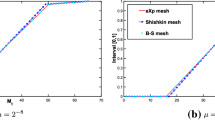Abstract
A bivariate spline method is developed to numerically solve second order elliptic partial differential equations in non-divergence form. The existence, uniqueness, stability as well as approximation properties of the discretized solution will be established by using the well-known Ladyzhenskaya–Babuska–Brezzi condition. Bivariate splines, discontinuous splines with smoothness constraints are used to implement the method. Computational results based on splines of various degrees are presented to demonstrate the effectiveness and efficiency of our method.



Similar content being viewed by others
References
Adolfsson, V.: \(L^2\) integrability of second order derivatives for Poisson equations in nonsmooth domain. Math. Scand. 70, 146–160 (1992)
Agranovich, M.S.: Sobolev Spaces, Their Generalizations and Elliptic Problems in Smooth and Lipschitz Domains, Springer Monographs in Mathematics. Springer, Cham (2015)
Awanou, G.: Robustness of a spline element method with constraints. J. Sci. Comput. 36(3), 421–432 (2008)
Awanou, G.: Spline element method for Monge–Ampère equations. BIT 55(3), 625–646 (2015)
Awanou, G., Lai, M.-J., Wenston, P.: The multivariate spline method for scattered data fitting and numerical solution of partial differential equations. In: Chen, G., Lai, M.J. (eds.) Wavelets and splines: Athens 2005, pp. 24–74. Nashboro Press, Brentwood (2006)
Babuska, I.: The finite element method with Lagrange multipliers. Numer. Math. 20, 179–192 (1973)
Brenner, S.C., Scott, L.R.: The Mathematical Theory of Finite Element Methods. Springer, New York (1994)
Brezzi, F.: On the existence, uniqueness, and approximation of saddle point problems arising from Lagrange multipliers. RAIRO 8, 129–151 (1974)
Ciarlet, P.G.: The Finite Element Method for Elliptic Problems. North-Holland, New York (1978)
Evens, L.: Partial Differ. Equ. American Mathematical Society, Providence (1998)
Farin, G.: Triangular Bernstein–Bézier patches. Comput. Aided Geom. Des. 3(2), 83–127 (1986)
Floater, M., Lai, M.-J.: Polygonal spline spaces and the numerical solution of the Poisson equation. SIAM J. Numer. Anal. 54, 797–824 (2016)
Grisvard, P.: Elliptic Problems in Nonsmooth Domains. Pitman, Boston (1985)
Gilbarg, D., Trudinger, N.S.: Elliptic Partial Differential Equations of Second Order. Springer, Berlin (1998)
Gutierrez, J., Lai, M.-J., Slavov, G.: Bivariate spline solution of time dependent nonlinear PDE for a population density over irregular domains. Math. Biosci. 270, 263–277 (2015)
Hu, X., Han, D., Lai, M.-J.: Bivariate splines of various degrees for numerical solution of PDE. SIAM J. Sci. Comput. 29, 1338–1354 (2007)
Kellogg, O.D.: On bounded polynomials in several variables. Math. Z. 27, 55–64 (1928)
Lai, M.-J., Schumaker, L.L.: Spline Functions Over Triangulations. Cambridge University Press, Cambridge (2007)
Lai, M.-J., Wenston, P.: Bivariate splines for fluid flows. Comput. Fluids 33, 1047–1073 (2004)
Maugeri, A., Palagachev, D.K., Softova, L.G.: Elliptic and Parabolic Equations with Discontinuous Coefficients. Mathematical Research, vol. 109. Wiley-VCH Verlag, Berlin (2000)
Mitrea, Dorina, Mitrea, Marius, Yan, Lixin: Boundary value problems for the Laplacian in convex and semiconvex domains. J. Funct. Anal. 258, 2507–2585 (2010)
Schumaker, L.L.: Spline Functions: Computational Methods. SIAM Publication, Philadelphia (2015)
Smears, I.: Nonoverlap** domain decomposition preconditioners for discontinuous Galerkin approximations of Hamilton–Jacobi–Bellman equations. J. Sci. Comput. (2017). doi:10.1007/s10915-017-0428-5
Smears, I., Süli, E.: Discontinuous Galerkin finite element approximation of nondivergence form elliptic equations with Cordes coefficients. SIAM J. Numer. Anal. 51(4), 2088–2106 (2013)
Smears, I., Süli, E.: Discontinuous Galerkin finite element approximation of Hamilton–Jacobi–Bellman equations with Cordes coefficients. SIAM J. Numer. Anal. 52(2), 993–1016 (2014)
Smears, I., Süli, E.: Discontinuous Galerkin finite element methods for time-dependent Hamilton–Jacobi–Bellman equations with Cordes coefficients. Numer. Math. 133(1), 141–176 (2016)
Süli, E.: A brief excursion into the mathematical theory of mixed finite element methods. In: Lecture Notes. University of Oxford (2013)
Wang, C., Wang, J.: An efficient numerical scheme for the biharmonic equation by weak Galerkin finite element methods on polygonal or polyhedral meshes. Comput. Math. Appl. 68(12, part B), 2314–2330 (2014)
Wang, C., Wang, J.: A primal–dual weak Galerkin finite element method for second order elliptic equations in non-divergence form, in revision, submitted to Math. Comput. ar**v:1510.03488v1
Wang, J., Ye, X.: A weak Galerkin mixed finite element method for second-order elliptic problems. Math. Comput. 83, 2101–2126 (2014)
Author information
Authors and Affiliations
Corresponding author
Additional information
The research of Ming-Jun Lai was partially supported by Simons collaboration Grant 280646 and the National Science Foundation Award DMS-1521537. The research of Chunmei Wang was partially supported by National Science Foundation Awards DMS-1522586 and DMS-1648171.
Rights and permissions
About this article
Cite this article
Lai, MJ., Wang, C. A Bivariate Spline Method for Second Order Elliptic Equations in Non-divergence Form. J Sci Comput 75, 803–829 (2018). https://doi.org/10.1007/s10915-017-0562-0
Received:
Revised:
Accepted:
Published:
Issue Date:
DOI: https://doi.org/10.1007/s10915-017-0562-0




